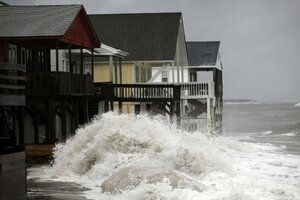Hurricane Sandy: How to process the threat with your kids
Hurricane Sandy has parents hitting the bottled water aisle at the supermarket and monitoring the growing threat on TV – and their children are listening in the background. Children can feel frightened but safe if parents process the drama of Hurriane Sandy realistically for them.

Hurricane Sandy, approaching the eastern seaboard of tthe US, sent waves crashing over protective sandbags in Ocean Isle Beach, N.C. Oct. 27, 2012. Sandy was expected to make direct impact Oct. 30 on the Mid-Atlantic or Northeast seaboard.
Reuters
I was five-years-old when Hurricane Gloria hit Boston in 1985. I remember playing card games by candlelight, while my teenaged brother sulked that he was missing Miami Vice.
Gloria was classified as a Category 1 hurricane. At the time, it was the first major hurricane system to reach the Northeast and move inland in more than 20 years.
RELATED: Are you a helicopter parent? Take our quiz
Over the next few days, Hurricane Sandy, another Category 1 storm, is expected to wind its way up the east coast, probably dealing out the most damage to the Mid-Atlantic and Northeast.
As parents hit the bottled water aisle at the grocery store and monitor the storm’s path, their children are listening in the background.
How can parents help their kids to process these kinds of events realistically without frightening them unnecessarily?
During Hurricane Gloria, I vaguely recall jumping as claps of thunder rattled the house and recently liberated tree branches whipped past the living room windows.
However, most of all, I remember a sense of delicious exhilaration as I sat with my family in the midst of deafening darkness, frightened yet safe.
Since then, I have experienced some crazy weather events. In fifth grade, Hurricane Bob uprooted a massive willow tree in my back yard. Lightning struck the hood of our family car while we were driving down the highway during a vacation in Florida, and in high school, an ice storm transformed the trees to glass.
Still, that memory of Gloria has persisted brightest, and I feel a bit of nostalgic excitement every time I hear of a coming hurricane.
While Sandy’s official status toggled back and forth over the weekend between tropical storm and hurricane, meteorologists warned for days that whatever it is could merge with another storm or two in the Northeast creating a massive, snowy hurricane that could last for several days.
Meteorologists have been predicting that if the perfect conditions converge, the Northeast could experience flooding characteristic of a 100-year storm.
Already, news images of flooded villages in the Caribbean and reports of more than two-dozen deaths credited to Hurricane Sandy are setting the tone for the storm’s arrival in the northeast.
On the one hand, fear – tempered by common sense – of the forces of nature does save lives. It informs building codes, emergency preparedness plans, and evacuation routes. Claps of thunder and sudden flashes of lightning keep kids away from windows and close to loved ones.
However, fear loses its usefulness if not balanced by that common sense. Adults are able to process the media hype that comes with big storms because we have a historical context in which to place them. Chances are that we have been through this before, and we know from experience that we will be safe, as long as we take a few precautions.
Young children need to hear this message explicitly.
Chances are, no matter how careful parents try to be, kids will come across images from the Caribbean and hear talk of the impending “Frankenstorm.”
Parents can be ready with assurances that they will be safe together.


